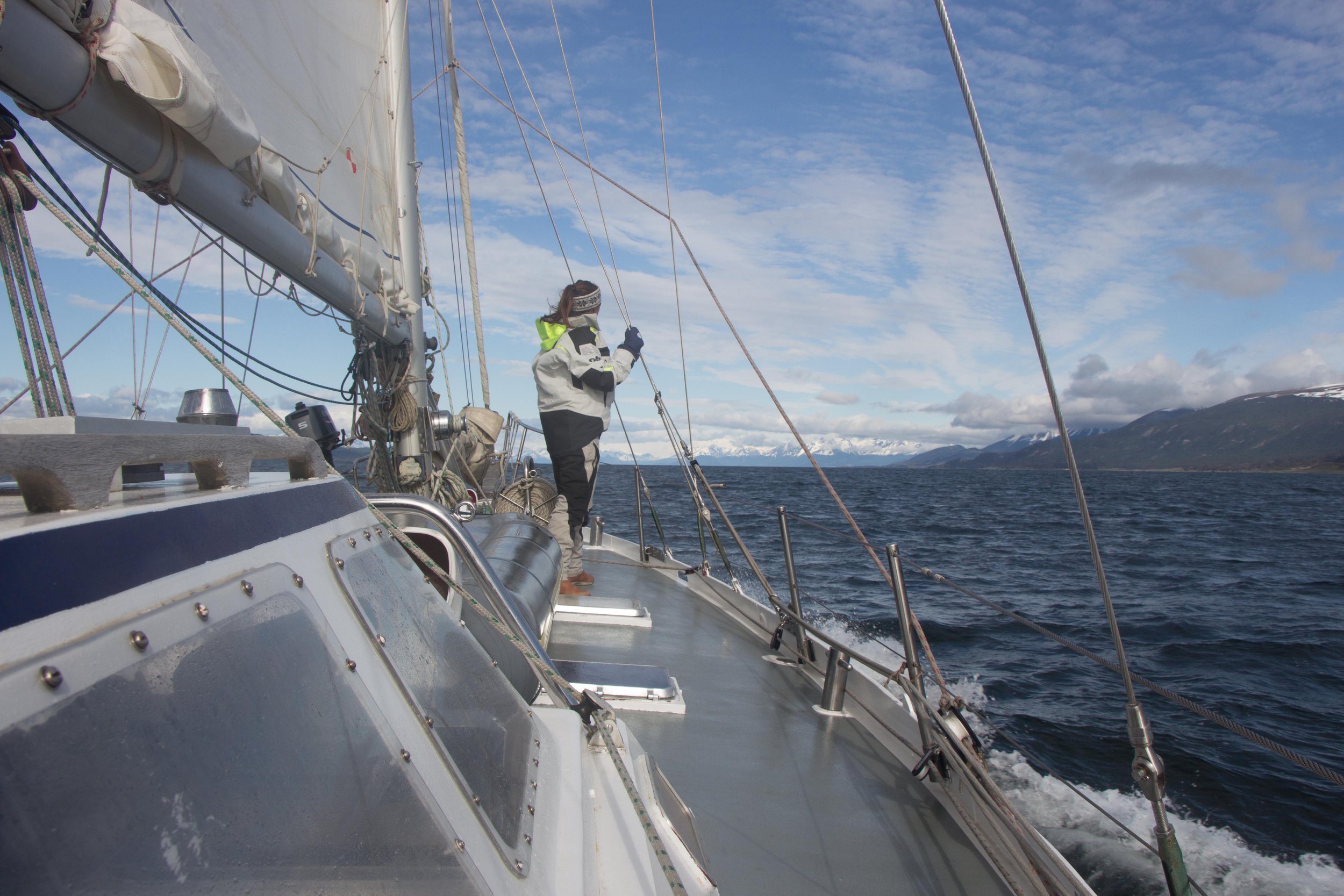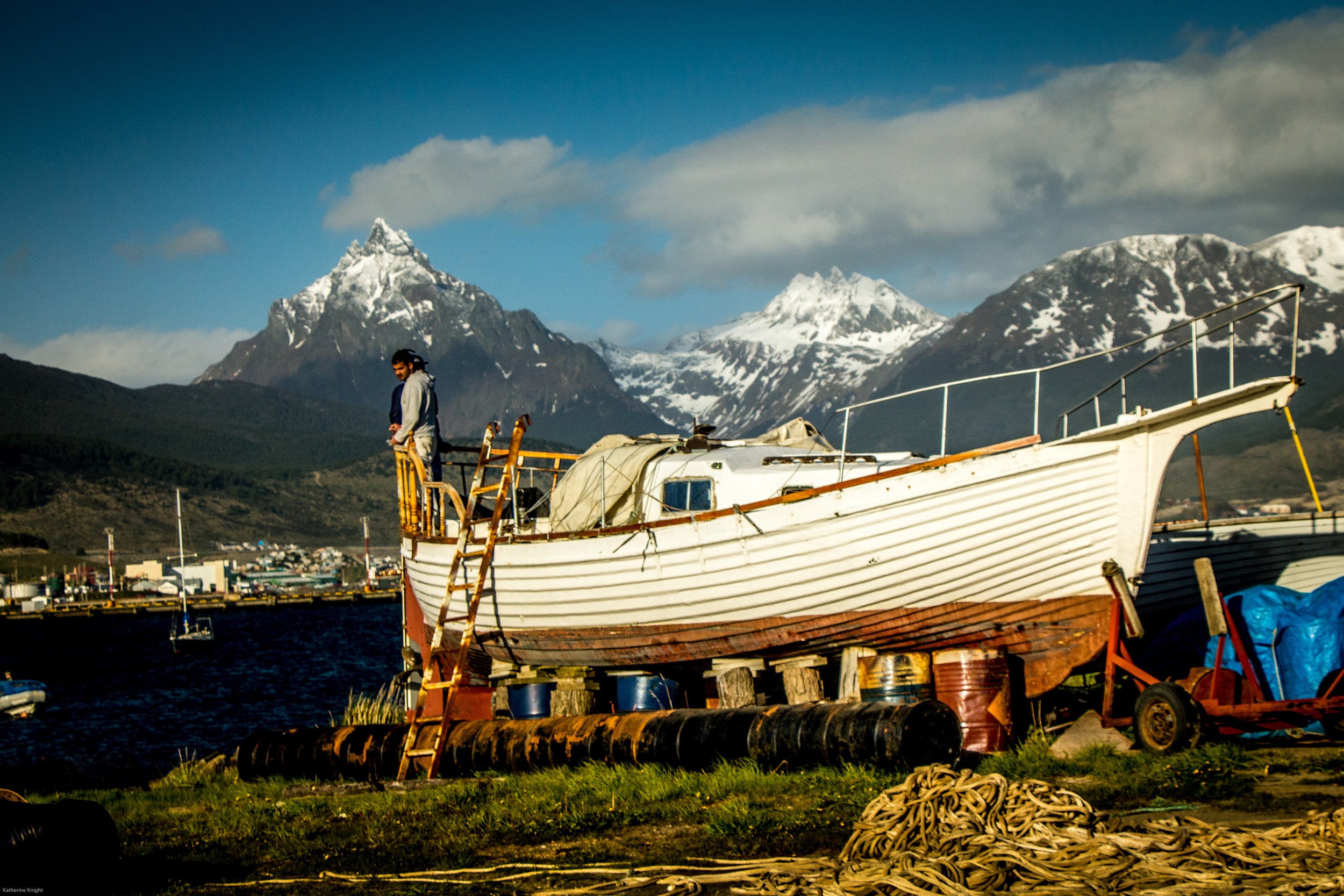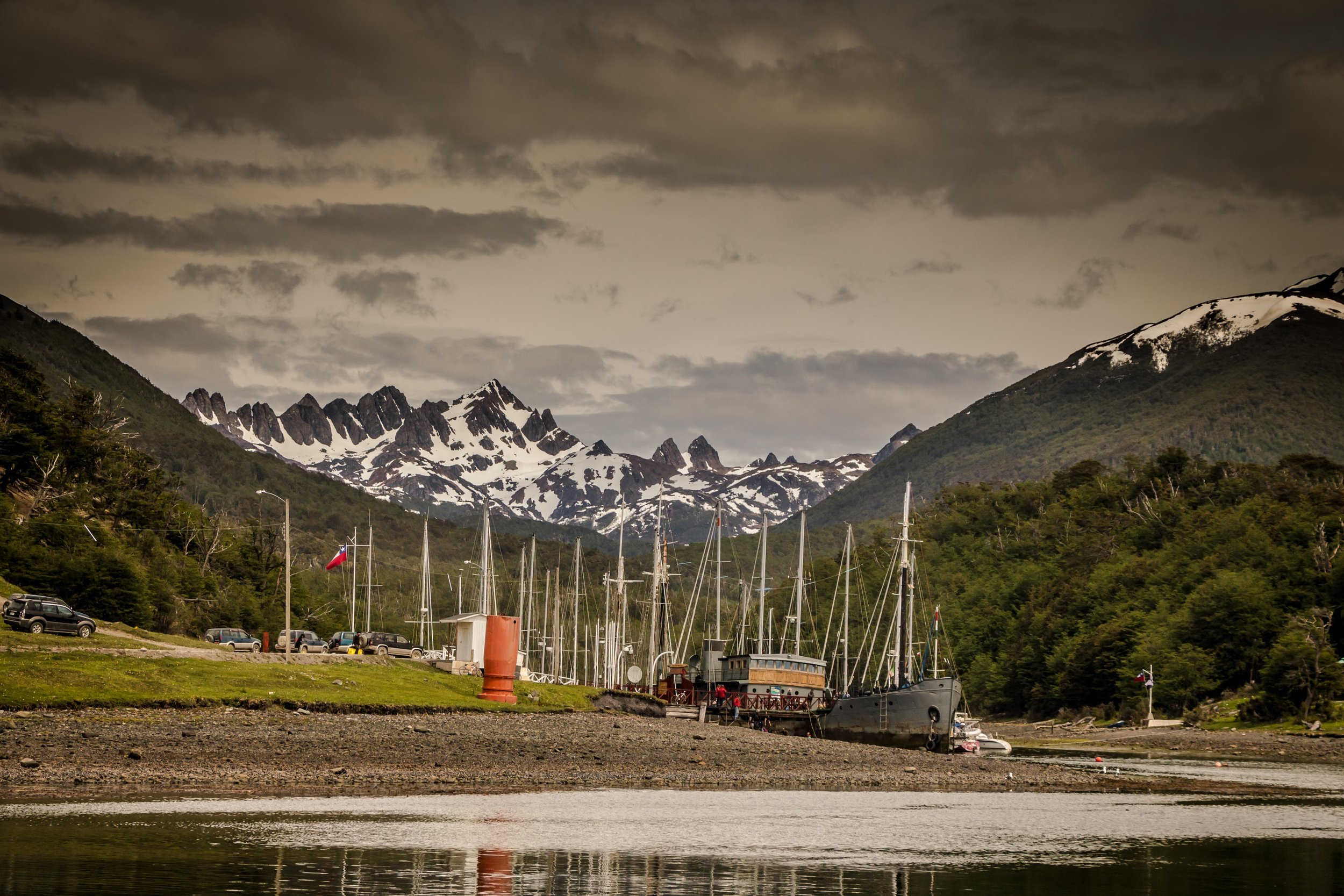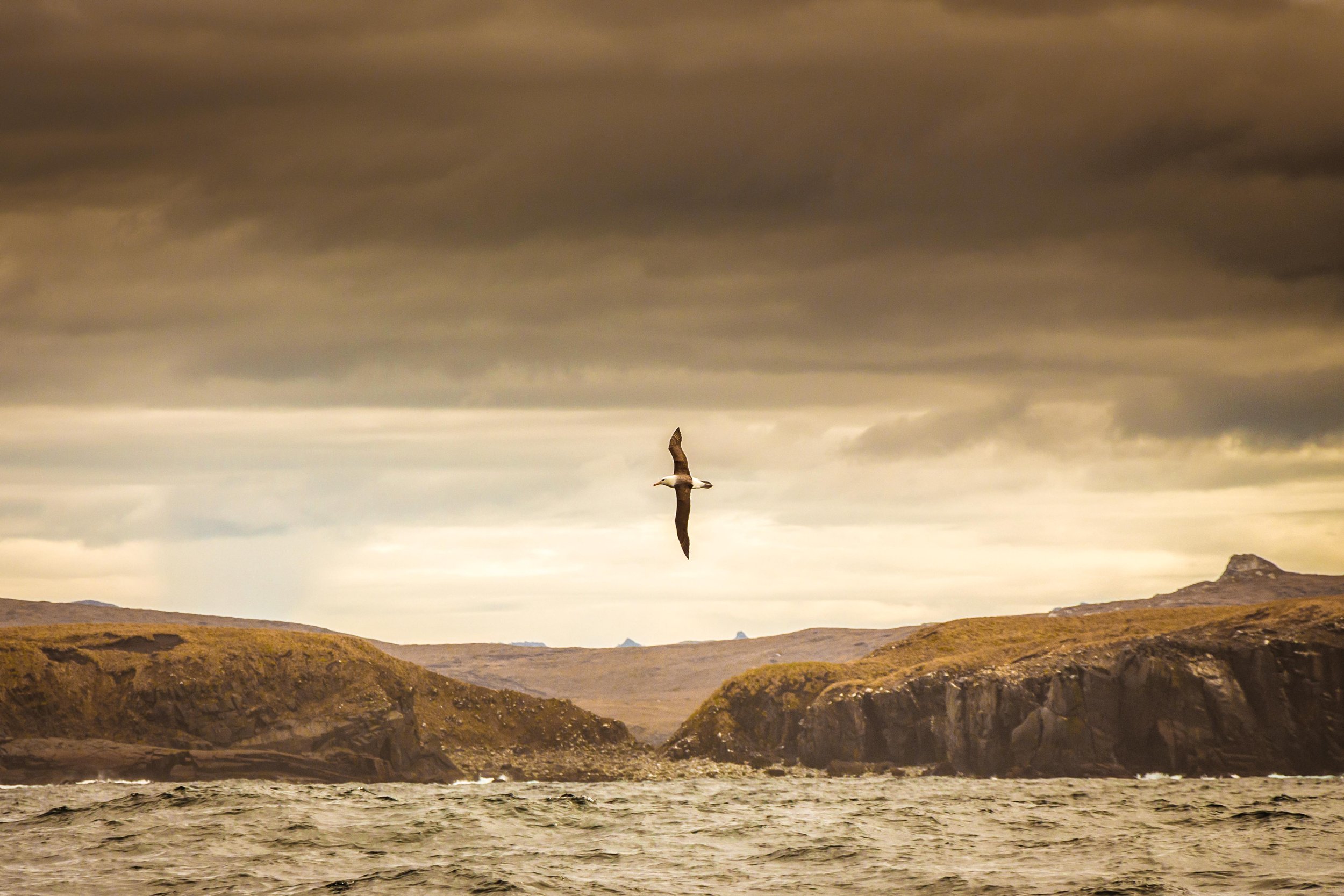Voyage to the End of the Earth
How does it feel to sail to the end of the Earth? Katherine sails through Patagonia and around Cape Horn to find out and invites you to share some magical experiences.

Ushuaia, the ‘end of the world’. For as long as I can remember these words have called to me vividly. Conjuring up images of explorers travelling into the unknown, the tantalising thought of what lies beyond the edge of the map, tempered by fear, will their boats fall off the edge of the world or be consumed by sea monsters? In this age of satellite mapping, the surface of the world can feel familiar to us all. With a couple of clicks we can see in high resolution what lies over the horizon. However what technology can not bring us is the experience of what it is like to be there. How does it feel to actually sail past the end of the Earth and look back at the last piece of land fading into the distance? What will it sound like, what emotions will it conjure up and what experiences will I have on the way? Join me on this journey in which Google Earth or not I will feel like a pioneer and there will be magnificent monsters of the deep.
A slight trepidation accompanies me as I board my third and final flight to the bottom of the world. It is not just the fact that this is the second time I am boarding this flight. The first time we boarded we were asked to disembark due to a technical problem. Mostly my trepidation comes from a geographical form of the saying ‘don’t meet your heroes’. Based on the assumption that after you have built them up in your mind then the reality is likely to be a let down. The mythical Ushuaia has been a hero of mine for many years, and I am about to meet him.

Like a nervous young lady arriving for a first date I peer out of the window of the plane searching for a first glimpse of Ushuaia. What will he look like? Will he be as I imagined? Safe behind my plexiglas window I feel as though I can size him up before he has a chance to see me. What a first glimpse it was. Towering peaks of snow capped mountains reared up to either side of the plane. The white capped maelstrom of the Beagle channel, upon which I will be sailing, slashing like a knife wound between the peaks. This is fittingly elementally raw scenery. This is the end of the world and the world isn’t going out with a whimper.
Ushuaia has the feel of a frontier town, a staging post clinging to the end of the land. Signs painted for the visiting cruise liner tourists proudly proclaim it’s status as “Fin del Mondo” the End of the World and “Gateway to Antarctica” which is only 1000km away. The main road illustrates Ushuaia's contrasts. A large casino paints the sky with it’s neon lights, just a short distance from where the St Christopher sits firmly aground. The St Christopher was a rescue vessel which worked this area and saved many lives in the waters around Cape Horn. She rests high and dry in front of the town as a memorial to the ships and lives that were lost. One of the crew joining me on our voyage appears quite touched looking at the St Christopher and tells me that his grandfather was onboard the first boat that she rescued.
An air of expectation hung over the Afasyn yacht club where expedition boats from all over the world were moored. Straining at their lines due to the ever present gale force winds. Or maybe they were just keen to set off on adventure. Finally the moment had arrived and we slipped our lines and sailed out into the Beagle Channel. It was an exhilarating sail, the boat bouncing over the wind whipped water, mountains to either side. Named Tierra del Fuego, Land of Fire, by the early explorers who saw smoke from the indigenous people's fires making it look as though the land was burning. We had our own land of fire effect created by low lying mist hugging the valleys. With the southern limit of the mainland of South America in our wake, all that was between us and the end of the world now were islands. Our first stop would be at the town of Porto Williams on Isla Navarino to allow us to complete the necessary customs formalities. Porto Williams has an intriguing yacht club. Nestled in a river mouth with snow capped mountains in the distance, you tie up alongside the yacht club, an old ship called the Micalvi, which provides the double function of club house and berthing facilities. The bar is like a giant visitors book of adventurers. It is covered floor to ceiling, and all across the ceiling, in flags, burgees and t-shirts from visiting yachts. All leaving their token as a sign that ‘we were here’.

Porto Williams, population 2000 is dominated by corrugated iron buildings. Some are arranged along the towns only gravel roads and some are scattered seemingly at random on patches of glass. Neat rows of buildings denote those belonging to the military. Horses and dogs roam freely around the town, as do the children. There was a party going on in the village square as we made our way to the customs building with many of the children in fancy dress. Micky and Mini Mouse strolling hand in hand along a dirt road was not what I had expected to find at the end of the world. There’s something you wouldn’t see on Google Earth. The supplies for the town arrive once a week by boat from Punto Arenas, a 3 day sea journey away. I noticed that along with the daily necessities you could buy Peppa Pig toys. I could have felt sad that globalisation had reached even this far corner of the world. However Peppa Pig is a favourite of my nephew and instead I found it heartwarming to think of the children here sharing the same enjoyment. A shared experience between children across the world that they are not even aware of. It reminded me that so often when I travel it is not the differences in the people that I meet but the similarities which are far more noticeable.
The next day would become forever etched in my mind as penguin day. Sailing from Porto Williams to Porto Torro we passed ‘Penguin Island’ home to a large colony of Magellan Penguins. I think penguins are awesome, whenever I think about them, I can feel ‘penguin excitement’ bubbling up inside me to escape in a great big smile. It is fantastic that an animal can have such an effect on us. The beach on Penguin Island was covered in Magellan Penguins with their distinctive pink patch around their eye. They were happily preening and popping in and out of the water. A Gentoo Penguin, bright orange beak, white stripe above the eye, rested by the side of the group, waiting to be joined by it’s partner who appeared, walking all of the way around the island in true comical penguin style, always looking like he was rushing forwards to catch his balance. On the top of the beach a solitary King Penguin. He was a little far from his usual home in Antarctica but seemed happy enough preening his black, white and yellow plumage. The smooth blending of the colours made it look as though he was made out of porcelain instead of feathers. Camera memory card full and big grin firmly planted in place we tore ourselves away from the penguins and continued eastwards past Picton Island. The wreck of the Evangelical Library ship which has remained where it went aground in the 1980’s serving as a reminder to take care with navigation. I’m not sure how an insurance company would feel about ‘distracted by penguin’ as a reason for a claim. This amazing bay was to have one more treat in store. A lone Black Browed Albatross appeared, circling and fishing just off our port bow. If penguins generate a feeling of happiness for me, then the albatross generates spontaneous awe. Seeing any bird demonstrating effortless mastery of flight is a treat but watching the albatross circling, skimming the water with barely a flap of it’s wings, was a special spectacle.

We stopped for the night to shelter from an incoming storm in the small fishing village and Navy outpost of Porto Torro. It was king crab season and the small dock was a hive of activity as the fishermen unloaded their catch. No surprises that fresh crab was on the menu that night. Further along the coast was the opportunity to indulge in one of my favourite childhood pastimes, rockpooling. The wealth of marine life more than made up for the lack of bucket and spade. My most prized find was an Anasterias Antarctica. The first animal that I have seen in the wild with ‘Antarctica’ in it’s name, I just wasn’t expecting it to be a starfish.
The storm abated and we said goodbye to Porto Torro and headed across the Bay of Nassau. The Bay of Nassau has a reputation for producing rough conditions, however calm waters greeted us. With the compass pointing tantalisingly due south we slid through the water, ever closer to the infamous ‘Horn’. A pod of Peate’s dolphins rushed over to join us. I rushed to the bowsprit and once again had a great big grin plastered to my face as the dolphins played under my feet. As we headed further south we saw more albatross gracing us with their presence. Snow capped mountains in the distance turned our minds to thoughts of unclimbed peaks and how to access them. That would have to wait for another day though. Slipping through the narrow passage between Isla Herschel and Isla Deceit we anchored at Calita Martiel. Tucked into this well sheltered anchorage we deployed the dinghy and went ashore. There are countless times, some admittedly when I should have been listening to more important things at school, that my mind has landed on a truly wild and deserted island for a Swallows and Amazons style adventure. And here we were, landing on a really properly wild, deserted island. The dinghy scrunched onto the beach. On the other side of the beach there was nothing but wilderness. No car park, no ice cream van, no road leading off to a nice bed and breakfast, nothing but wildness. The interior of the island was defended from would be explorers by dense trees. Known as ‘flag trees’ which have been so bombarded by the prevailing wind that that they grow practically along the ground as if they are sleeping. I found an area of less thick vegetation and made my way into the woodland. It is a surreal experience to stand in a woodland and to be taller than the trees, looking out across the canopy like a giraffe.
Back on board we lit the heater and had a cosy dinner. I asked the skipper Atilo about some of the pieces of pottery that were on the boat. He told me that they were from and expedition that he had guided consisting of divers who were looking for the remains of the Hoorn, a Dutch ship that sank in the Beagle Channel. Despite the loss of this ship, the remaining boat in the two boat Dutch expedition went on to discover Cape Horn. They named this infamous point after the lost vessel and their Dutch hometown of Hoorn. All this talk of Cape Horn was whetting our appetite, as tomorrow was the big day, we were going to sail around the bottom of the Earth.

Whales, dolphins, penguins, albatross and the end of the world - a pretty good day! From the first glimpse of the fabled rock to the champagne shared between the crew and Neptune as we rounded the end of the world, it was quite a momentous day. A massive highlight was watching the albatross wheel effortlessly in front of the albatross statue erected on Cape Horn to commemorate those lost at sea. The statue depicts their souls riding the oceans forever on the wings of an albatross. So how did it feel? As the swell of the Southern Ocean heaves and rolls past this speck of land the sense of being beyond the end of the world was tangible, like letting go of the edge of the swimming pool for the first time and looking back to see a gulf between you and the rest of the world. Looking south across the grey vastness that doesn’t end until Antarctica was reminiscent of standing at the top of a shear drop, the vastness bringing with it it’s own sense of vertigo. The weather being favourable we were able to tuck into a small anchorage on the eastern side of the island of Cabo de Hornas and set foot on the island. As we deployed the dinghy we shared the anchorage with the Chilean navy who were ferrying tanks of water ashore to supply the officer and his wife whose turn of duty it was to man the Cape Horn outpost. One of the jobs of this officer was to administer to the immigration requirements of foreign visitors, this time our passports were stamped with a really special stamp, an image of the island flanked by two penguins. Probably more to cater to tourism needs than official requirements but I was pretty excited to have penguins in my passport, surely that must mean that you are a real explorer.
We were reaching the end of the time allocated for our trip and so heads full of wonderful and beautiful memories we headed north once more. It might have been the homeward bound leg but Patagonia still had some treats in store. It had been a long day and most of the crew were below decks getting themselves warmed up. I decided I would rather just put on an extra coat and more gloves so I could stay on deck by myself savouring the changing colours of the sunset. The sky turned to molten fire as the sun illuminated the underside of the clouds. Suddenly this distant display was interrupted by a cloud of spray, the unmistakable blow of a Minkie whale. I gave out a shout of ‘baleen’ the Spanish for whale and about the extent of my grasp of the language despite a week with a Spanish speaking crew. At least I had learnt the important things. The rest of the crew raced on deck in time to see this majestic creature of the deep surface a couple more times before making his unhurried way off into the sunset.
Some days I find that despite being somewhere stunning my camera just doesn’t want to take good pictures, while other days the scenery seems to want to jump into my lens. Today was one of those days and I snapped away happily on the fore deck. Each time we rounded a bend in the channel a new vista rolled into view, mountains to either side with our little slice of water heading to a vanishing point in their rocky embrace. When I visit somewhere new I often find myself wondering how it would have looked to the first explorers to set eyes on it. An expanse with nothing but nature and wildness. Sailing up the Beagle Channel my mind wandered to the deck of the Beagle. I imagined looking out through her Captain’s eyes, how would this undiscovered world have looked all of those years ago? Then I was struck with the realisation that it would have looked exactly as it does to me now. Standing on deck I am not able to see one single sign of man’s influence. For this magical moment I could be a pioneer on the Beagle sailing off the edge of the map.




